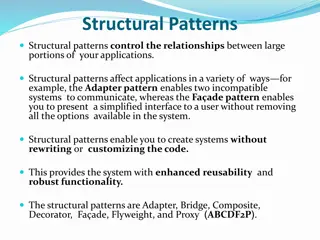
Exploring Decorator Design Pattern and Extending Functionality
Dive into the Decorator pattern and its goals, such as attaching additional functionalities to existing classes at runtime while avoiding excessive subclassing. Learn how to extend functionality in a structured manner, addressing issues like excessive subclasses and hierarchy complexities, with a focus on maintaining code integrity.
Download Presentation

Please find below an Image/Link to download the presentation.
The content on the website is provided AS IS for your information and personal use only. It may not be sold, licensed, or shared on other websites without obtaining consent from the author. If you encounter any issues during the download, it is possible that the publisher has removed the file from their server.
You are allowed to download the files provided on this website for personal or commercial use, subject to the condition that they are used lawfully. All files are the property of their respective owners.
The content on the website is provided AS IS for your information and personal use only. It may not be sold, licensed, or shared on other websites without obtaining consent from the author.
E N D
Presentation Transcript
Reading: Design Patterns Explained, Ch. 17 SWE2410 Design and Cloud Patterns Dr. Rob Hasker (based on slides by Dr. Mark Hornick) 5. Decorator
Pattern Review What elements do we need? What problem do patterns solve? How do they fit in the design process? Why are patterns typically part of design, not problem analysis? That is, domain engineering = problem analysis/requirements Design: detailed system structure, algorithms, patterns
// CONSIDER: Example: Ice Cream Store private static float BIG_VALUE = 1e8F; public class Money { public static void main(String[] args) { float num = BIG_VALUE; for(int i = 0; i < 1000; ++i) num += 1.0; System.out.println(BIG_VALUE + " + 1000: " + num); Confection: a dish or delicacy made with sweet ingredients IceCreamConfection: either an interface or abstract Show methods once! Description: maybe an attribute, maybe computed Why might costInCents return an int? num = 0.0F; for(int i = 0; i < 1000; ++i) num += 1.0; num += BIG_VALUE; System.out.println("1000 + " + BIG_VALUE + ": " + num); } } // output: 1.0E8 + 1000: 1.0E8 1000 + 1.0E8: 1.00001E8 Doubles would only help a bit
public abstract class IceCreamConfection { Implementing the core classes public abstract String description(); public abstract int costInCents(); } public class Cone extends IceCreamConfection { public String description() { return Cone ; } public int costInCents() { return 124; } }
Extending functionality Store sells many topics: fudge, M&Ms, peanuts Each topping: additional cost If they are free, could lead to abuses Issue: how to account for these additions to products?
Decorator Pattern: Goals More general goal: attach additional functionality to an existing class at runtime Another goal: avoid extra subclassing That is, don t create a subclass for each type of product Issue: Too many subclasses Issue: The classes might be in other hierarchies Additional goal: avoid modifying existing classes especially critical when no access to source or the base class is used elsewhere
Alternative 1: Create a new class for each combination. Ice Cream Toppings What can go wrong? Cone M&M Dish Fudge WaffleCone Peanuts Results in class explosion! What happens when a new topping is added? What happens when the cost of a topping (e.g. fudge) changes? Maintenance nightmare! Caramel
Alternative 2: Add flags for the toppings abstract class IceCreamConfection { public int toppingCost() { int toppingCost = 0; if (hasFudge()) toppingCost += FUDGE_COST; if (hasCaramel()) toppingCost += CARAMEL_COST; return toppingCost; } } public class Cone extends IceCreamConfection { public int costInCents() { return 124 + super.toppingCost(); } } IceCream -description: String -hasFudge: boolean -hasMnM: boolean ------- +getDescription() +cost() +hasFudge() +hasCaramel() ------
So, whats the (general) problem? Adapt to new behavior Leave existing code unchanged Support future changes in requirements Solution: Decorator Pattern Introduce abstract class for the new behavior Allow that class to access the original object
DecoratedConfection: abstract since need common wrappedItem for all decorations Decoration: gives a new item that has all of the same properties, interface as the original An IceCreamWithFudgealso defines costInCents(), description()
abstract class DecoratedConfection implements IceCreamConfection { protected IceCreamConfection wrappedItem; public DecoratedConfection(IceCreamConfection icc) { wrappedItem = icc; } public double costInCents() { return wrappedItem.costInCents() + 25; } // 25 cent toppings } public class IceCreamWithFudge extends DecoratedConfection { public IceCreamWithFudge(IceCreamConfection icc) { super(icc); } public String description() { return wrappedItem.description() + with fudge ; } }
Using the Decorator Pattern Start by creating an IceCreamConfectionobject: IceCreamConfection toServe = new Cone(); Decorate it with the Fudge topping. Create a IceCreamWithFudge object and wrap it around the item to serve: toServe = new IceCreamWithFudge(toServe); Decorate it with the Nuts topping. Create a IceCreamWithNuts object and wrap it around the item to serve: toServe = new IceCreamWithNuts(toServe); Extra nuts: toServe = new IceCreamWithNuts(toServe); So get two IceCreamWithNuts decorators! Calculate cost with all toppings: Int total = toServe.costInCents(); Memory Map See next page for sequence
Memory Map Question: how to support a two-scoop cone?
Warning: Base class, Component, must be an interface Otherwise, any values in Component will have multiple versions: one in the ConcreteComponentA or B instance, another in every decorator instance Loss of identity: which instance is the real one with the actual attribute? If need common attributes between ConcreteComponentA & B, add an abstract class!
Whats going on here? Open-closed principle: Classes should be openfor extension, but closedto modification Can extend at will No final classes!? Supports new applications of existing code Don t alter the existing code! It may be used elsewhere! At the least it means new unit tests
Evaluation What s good about the decorator? What s bad? Impact on coupling? Impact on cohesion?
Summary Decorators: same super-type as objects being decorated One or more decorators can be used to wrap an object Can pass decorated object anywhere original can be passed Decorated: adds behavior before or after delegating to the decorated object Can decorate objects at run time with multiple decorators Supports open-closed principle: open to extension, closed to modification
java.io: many classes for I/O OutputStream, FileOutputStream, PipedOutputStream, DataOutputStream, ObjectOutputStream, PrintStream, PrintWriter, Associations between these not clear from Java API documentation
class Output Stream Decorators io::FilterOutputStream But note: simply applying Decorator io::OutputStream # out: OutputStream + write(int) : void + write(byte[]) : void + write(byte[], int, int) : void + flush() : void + close() : void + FilterOutputStream(OutputStream) + write(int) : void + write(byte[]) : void + write(byte[], int, int) : void + flush() : void + close() : void #out io:: io:: io::DataOutputStream ObjectOutputStream PipedOutputStream io::FileOutputStream Writer io::PrintWriter Appendable io::PrintStream -psOut
class Input Stream Decorators io::FilterInputStream io::InputStream # in: volatile InputStream - - SKIP_BUFFER_SIZE: int = 2048 {readOnly} skipBuffer: byte ([]) Decorator pattern applied to input streams: # FilterInputStream(InputStream) + read() : int + read(byte[]) : int + read(byte[], int, int) : int + skip(long) : long + available() : int + close() : void + mark(int) : void + reset() : void + markSupported() : boolean + read() : int + read(byte[]) : int + read(byte[], int, int) : int + skip(long) : long + available() : int + close() : void + mark(int) : void + reset() : void + markSupported() : boolean #in io:: BufferedInputStream io::PipedInputStream io:: LineNumberInputStream io::FileInputStream io::StringBufferInputStream Create custom stream decorators by extending FilterOutputStream and FilterInputStream











